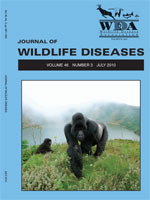Avian botulism outbreaks are frequently perpetuated by type C toxin produced by Clostridium botulinum proliferating in decomposing bird carcasses and consumption of toxic maggots from these carcasses by healthy birds. Therefore, removing bird carcasses has been advocated for disease management because availability of toxic maggots should be reduced, increasing duck survival. However, this management is expensive, and its effect on waterfowl mortality under field conditions is unknown. We radio-marked 419 molting mallards on 11 lakes in western Canada during July–August 1999–2001 and monitored them for 30 days, testing whether survival was higher on lakes with carcass removal. Botulism occurred on 10 lakes. On five carcass removal lakes, greater-than-normal effort was made to conduct early, thorough surveillance and immediately remove carcasses; on six nonremoval lakes, no carcasses were removed. In 1999, estimated 30-day survival probabilities ranged from 0.149 (95% CI=0.065–0.304) on one large lake with carcass removal to 0.466 (95% CI=0.270–0.674) and 0.618 (95% CI=0.443–0.767) on two nonremoval lakes. As a result, we conducted work on smaller wetlands thereafter, reasoning that any management benefit would be easier to detect. In 2000, estimated 30-day survival probabilities were 0.313 (95% CI=0.143–0.556) and 0.794 (95% CI=0.609–0.905) on two carcass removal lakes versus 0.525 (95% CI=0.362–0.682) and 0.743 (95% CI=0.564–0.866) on two nonremoval lakes. In 2001, botulism was detected on two nonremoval lakes where survival probabilities were 0.845 (95% CI=0.630–0.946) and 0.942 (95% CI=0.778–0.987), and on one removal lake where survival probability was 1.0 (95% CI=0.99–1.0), but not detected on the other removal lake where no marked birds died from botulism (1.0, 95% CI=0.99–1.0). Survival tended to be higher on lakes with lower carcass density, but when data were organized by carcass removal versus nonremoval, mallard survival was not consistently greater on lakes where carcasses were removed.
How to translate text using browser tools
1 July 2010
SURVIVAL OF RADIO-MARKED MALLARDS IN RELATION TO MANAGEMENT OF AVIAN BOTULISM
Daniel D. Evelsizer,
Trent K. Bollinger,
Kevin W. Dufour,
Robert G. Clark
ACCESS THE FULL ARTICLE

Journal of Wildlife Diseases
Vol. 46 • No. 3
July 2010
Vol. 46 • No. 3
July 2010
Anas platyrhynchos
avian botulism management
Clostridium botulinum type C
mallards
radio-telemetry
survival
Western Canada




